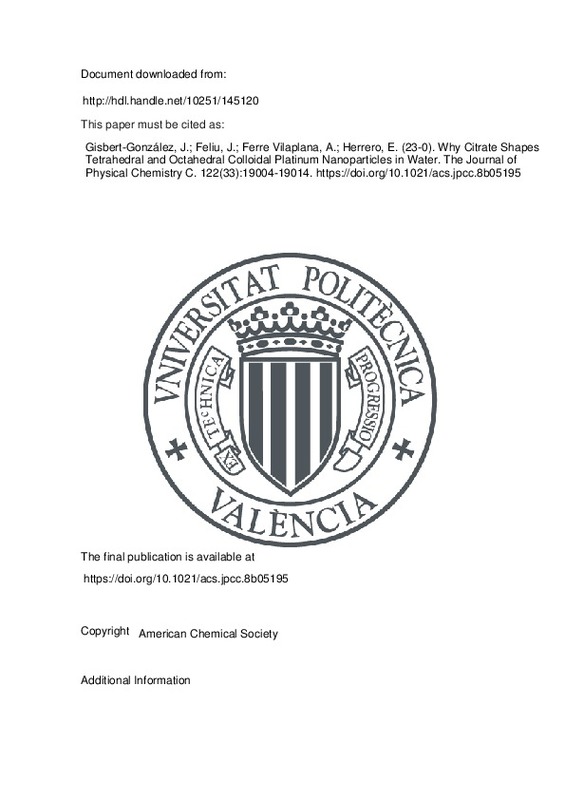JavaScript is disabled for your browser. Some features of this site may not work without it.
Buscar en RiuNet
Listar
Mi cuenta
Estadísticas
Ayuda RiuNet
Admin. UPV
Why Citrate Shapes Tetrahedral and Octahedral Colloidal Platinum Nanoparticles in Water
Mostrar el registro sencillo del ítem
Ficheros en el ítem
| dc.contributor.author | Gisbert-González, J.M.
|
es_ES |
| dc.contributor.author | Feliu, Juan
|
es_ES |
| dc.contributor.author | Ferre Vilaplana, Adolfo
|
es_ES |
| dc.contributor.author | Herrero, Enrique
|
es_ES |
| dc.date.accessioned | 2020-06-03T05:53:21Z | |
| dc.date.available | 2020-06-03T05:53:21Z | |
| dc.date.issued | 2018-08-23 | es_ES |
| dc.identifier.issn | 1932-7447 | es_ES |
| dc.identifier.uri | http://hdl.handle.net/10251/145120 | |
| dc.description.abstract | [EN] The performance of many advanced catalytic systems depends not only on the size and composition but also on the specific shape of the metal nanoparticles (NPs) from which they are assembled. In turn, the shape of colloidal NPs depends on the specific capping agent involved in their synthesis, though the mechanism is still poorly understood. Here, supported by electrochemical experiments, Fourier transform infrared spectra, and density functional theory calculations, on well-defined surfaces, we show how a specific capping agent determines the shape of colloidal NPs. Solvated citrate can become simultaneously adsorbed on the Pt(111) surface through three dehydrogenated carboxylic groups, with each one of them in bidentate configuration. On the other two basal planes, citrate can be adsorbed through only two of them. For this reason, under the synthesis conditions, citrate is more favorably adsorbed on the Pt(111) than on the other two basal planes of platinum. This adsorption behavior explains why colloidal platinum NPs of tetrahedral and octahedral shape are produced when citrate is used as the capping agent in water. The mechanism for citrate would also determine the shape of other pure face-centered cubic metals and can inspire the engineering of future capping agents. | es_ES |
| dc.description.sponsorship | This work has been financially supported by the MCINN-FEDER (Spain) through project CTQ2016-76221-P. | es_ES |
| dc.language | Inglés | es_ES |
| dc.publisher | American Chemical Society | es_ES |
| dc.relation.ispartof | The Journal of Physical Chemistry C | es_ES |
| dc.rights | Reserva de todos los derechos | es_ES |
| dc.subject.classification | LENGUAJES Y SISTEMAS INFORMATICOS | es_ES |
| dc.title | Why Citrate Shapes Tetrahedral and Octahedral Colloidal Platinum Nanoparticles in Water | es_ES |
| dc.type | Artículo | es_ES |
| dc.identifier.doi | 10.1021/acs.jpcc.8b05195 | es_ES |
| dc.relation.projectID | info:eu-repo/grantAgreement/MINECO//CTQ2016-76221-P/ES/ESTRUCTURA INTERFACIAL Y REACTIVIDAD ELECTROQUIMICA/ | es_ES |
| dc.rights.accessRights | Abierto | es_ES |
| dc.contributor.affiliation | Universitat Politècnica de València. Departamento de Sistemas Informáticos y Computación - Departament de Sistemes Informàtics i Computació | es_ES |
| dc.description.bibliographicCitation | Gisbert-González, J.; Feliu, J.; Ferre Vilaplana, A.; Herrero, E. (2018). Why Citrate Shapes Tetrahedral and Octahedral Colloidal Platinum Nanoparticles in Water. The Journal of Physical Chemistry C. 122(33):19004-19014. https://doi.org/10.1021/acs.jpcc.8b05195 | es_ES |
| dc.description.accrualMethod | S | es_ES |
| dc.relation.publisherversion | https://doi.org/10.1021/acs.jpcc.8b05195 | es_ES |
| dc.description.upvformatpinicio | 19004 | es_ES |
| dc.description.upvformatpfin | 19014 | es_ES |
| dc.type.version | info:eu-repo/semantics/publishedVersion | es_ES |
| dc.description.volume | 122 | es_ES |
| dc.description.issue | 33 | es_ES |
| dc.relation.pasarela | S\373776 | es_ES |
| dc.contributor.funder | Ministerio de Ciencia e Innovación | es_ES |
| dc.contributor.funder | Ministerio de Economía y Competitividad | es_ES |







![[Cerrado]](/themes/UPV/images/candado.png)

